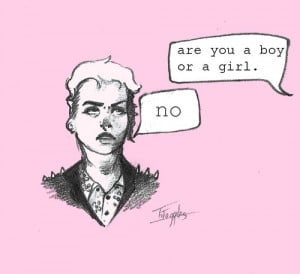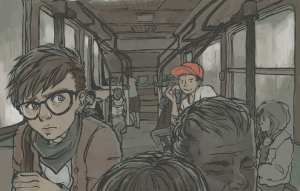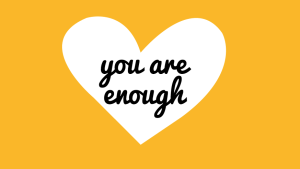
Source: iStock
I often hear people talk about pregnancy from a space of gratitude – and sometimes excitement.
Though I agree that the journey is incredible and enriching, there is another, perhaps less embraced aspect: For me, pregnancy was also full of moments of intense vulnerability, fear, and at times, anger.
I felt fearful about my own safety, it being so inextricably linked with the safety of the person growing in my belly.
Inadvertent pushes from someone who stood in a line behind me, an overly-ambitious driver who darted across me at an intersection, a woman who threatened me because she (wrongly) assumed I stole her parking spot – all those instances of intense vulnerability and primal fear, stemming from my need to protect my future child.
Even more unnerving were the instances where physical contact with my belly wasn’t just implied, it was accomplished.
This is where my anger would rise to the surface – I’d get angry at the people who felt completely within their rights to touch my belly, to touch my baby. Whether from an elderly man or a woman who was also a mother, I resented them for feeling okay with touching my child without permission, even when she was in utero.
For sure, I felt uncomfortable with them trying to touch my body – and all that that says about being a woman in public space. But more than that, it clued me in to many adults’ idea that they don’t need children’s permission to touch them – or to require that they touch someone else.
Today, my daughters are twelve and ten, and I still feel the need to protect them physically – and to advocate for their right to govern their own bodies.
But I have to do more than advocate for them.
In a world that constantly sends messages to women about connecting their value with their physicality and desirability, I need to help them operate with an awareness of their right to reject or accept physical touch, or any act that affects their personal space or feeling of safety, from any adult or child.
And that means I have to be honest about the ways that I, myself, might infringe on their personal boundaries, and I have to facilitate these conversations with the adults around me.
And I don’t just mean conversations about what we can do to protect children, but what we must do to help children understand their options for protecting their physical and emotional selves.
One way we can approach this goal is to explore some of the common mistakes we adults make when it comes to helping children practice bodily autonomy, which is at the root of consent culture for children.
Otherwise, we will continue to do the things that compromise the self-confidence, the sense of safety/ bodily autonomy, and the mental wellness of the children we love.
Because the reality is that children are coerced into situations where their bodies are treated as the property of their parents.
The instances vary from making them hug a family member to trading their body for sex, drugs, or even food. All of these instances can send a message to children that their bodies are not their own.
They also blur the lines between safe and unsafe touch, or consent versus coercion, and make it difficult for many children to identify when they’re being inappropriately or uncomfortably touched by an adult or another child.
Many of us send messages that lessen their ability to recognize and trust what feels safe and uncomfortable for them, as well as how to confidently communicate with an adult that they trust when their personal boundaries are violated by anyone, including an adult or child they know and trust.
Statistically, the percentages are wildly unnerving: 90% of child sexual abuse victims know the perpetrator in some way, and 68% are abused by family members.
What’s more staggering is that 90% are abused by someone they know, love, or trust, and that 20% of child sexual abuse victims are under the age of eight. Most of them don’t tell until they become adults.
One of the reasons for this is that as children, they didn’t have language around those feelings. No one was talking to them about their right to feel safe in their own bodies – to have and assert personal boundaries as a way of protecting themselves.
Consent culture is often confined to the topic of consensual sex or intimacy among adults, and that it should extend toward all behaviors and to children. Similarly, the term bodily autonomy tends to be more widely recognized under a specific topic: reproductive justice advocacy – and more specifically, the pro-choice movement among abortion rights.
So as to extend these important concepts beyond the scope of sex and reproduction, let’s look how parents’ mistakes around bodily autonomy can contradict the practice of consent culture among children.
Because when children don’t feel sure about inappropriate touch, we must look at the narratives around body ownership and consent. For this reason, we must look at confident body autonomy for all people, even before they become adults, and outside of the context of sex.
Mistake #1: Teaching Children to Ignore Personal Boundaries
In the US, we have a subtle history of showing children that their bodies are owned by their parents.
Forced physical contact with relatives reinforce the dangerously wrong message that relatives can’t be abusers. “Grandpa just wants to hug you – don’t back away,” or other similar verbal prompts, tell children to ignore their feelings about a person (whether based on intuition or past experience) and listen to what an adult says instead.
As well-meaning observers, we adults often infringe on personal boundaries within children’s interactions.
Coercing a reserved child to hold hands and dance around with an outgoing child may feel like we’re helping that child develop good social skills.
But what we may actually do is teach them that it’s okay for other people to force them to do what makes them (or other people) comfortable.
In later years, that can cause some children to feel that they need to be forced to do things, or that their natural tendency is somehow not okay. This can also have long-term negative effects on their social skills because self-esteem and authentic friendships are difficult to form and maintain when a person isn’t okay with who and how they innately are.
Also, many children who endure sexual abuse in particular don’t tell because they’re afraid of being blamed for being complicit in the abuse.
This tells us that children don’t understand abuse. That’s in part because we, the adults, don’t give them the language to name these experiences, and to feel safe coming to us about them.
Difficult aspects of personal boundary violation, particularly peer-to-peer abuse, make it extra complicated for adults to feel clear on how to broach the topic with children. But children need to know that other children can be abusers and that they can abuse another child by touching them without permission, even if that child told them yes in the past.
Whether subtle or overt, the effects of childhood body violations are that we don’t feel that we own ourselves. I know this from personal experience. We feel uncomfortable, unsure, or even afraid about asserting dominion over our own bodies.
And again, it’s important to realize that our bodies and our boundaries exist outside of sex, and consent is required for anything having to do with our bodies.
A solution to the blurred lines of personal boundaries is to practice parenting without coercion.
Consent culture should start with children – and when children grow up believing that all people have the right to control and protect their own bodies, then they’re likely to respect other people’s boundaries, and to speak up when boundaries – whether their own or those of others – are being violated.
Mistake #2: Reinforcing Shame or Silence Around Body-Related Feelings
Instead of starting positive, developmentally appropriate conversation about bodies, sex, and intimacy in general, many parents tend to omit those terms when conversing with their children.
But getting comfortable with saying penis, vagina, anus, or even the more popular (and maybe less easy to hear from a child) slang terms like butthole, for example, can lessen the feeling of shame around talking about private body parts or body-related feelings.
These same types of conversations can also help children feel equipped to communicate with someone they trust if they are being sexually violated, for example. This way, we’re not just giving them language about what’s happening with them, we’re also helping them express what’s happening to them.
If they’re comfortable naming them, then they have language to utilize when those body parts are affected by anyone in any way.
Another word that often goes unspoken among parents to children in healthy ways is masturbation. It’s normal for children’s curiosity to include their own bodies, sometimes showing up as self-pleasuring.
Labeling that form of self-exploration as bad, or avoiding the topic with your child altogether, can make it difficult for a child to feel comfortable with their own bodies and physical feelings. As caring adults, one way we can nurture safe space for children is to educate ourselves on taboo topics like masturbation and children, particularly prepubescent children.
Some of us may have incorrect ideas about masturbation based on our parents’ perspectives or other aspects of our own introduction to sexuality. But our children are not us, and though they are our responsibility, their bodies and experiences are their own.
In support of that, we can read, discuss, and watch our way towards a sex-positive approach to parenting so that our children feel safe asking questions, and knowing (from experience) that they can discuss any aspect of their bodies with us, including sensations and thoughts that they may find pleasurable.
Personally, I address masturbation with my daughters in part because I don’t ever want to set the precedent that anyone (not even their mother) needs to validate how to explore aspects of their sexuality.
My intention is to avoid making masturbation an issue of morality or appropriateness, and instead focus on what is socially safe and personally hygienic. In other words, as Lea Grover so perfectly stated, “We don’t play with our vulvas at the table.”
Mistake #3: Neglecting to Teach Your Child the Importance of Their Intuition
Intuition is not exclusive to adulthood, and it can play a very helpful role in helping a child develop a healthy sense of bodily autonomy.
At any age, we have feelings in our bellies or chests, for example, that are directly triggered by feelings of safety or lack thereof.
Help children to name and acknowledge those feelings – and to trust them.
One way I practice nurturing intuition is to help children understand what intuition does. For my girls, I like the simple definition of intuition as a kind of internal safety alarm. I give them specific examples of times that I listened to my intuition and kept myself safe, and times that I ignored my intuition, and wasn’t sure how to protect myself when I faced danger.
I’m not always sure if this is effective, but it helps me be sure that I’m practicing what I believe will work, and what has worked with them in prior instances.
Asking them how intuition feels for them is good, too. That way, they’ve verbalized the feelings and can more easily recognize and even share them when they show up.
Some parents tend to direct their child on how they should interact with a new adult, instead of watching and seeing how their child responds to them and going from there. That’s an example of intuitive interference.
In order for a child to develop a sense of trust in their own intuition, we as parents have to respect their choices, and decide on a safe place and time to discuss the interaction and see if our child has questions. This is where we parents can be advocates and allies for our children.
For example, if I meet up with a friend who has an outgoing child and I have my bona fide introvert in tow, I tell that parent know that my daughter may or may not play with their child. Or that she may not hug them, nor participate in any well-meaning small talk.
I often bring books, games, and even art supplies along so that my daughter can feel comfortable in that setting (where she’s accompanying me somewhere) without feeling pushed to engage with anyone, child or adult, unless she chooses to do so.
We can also tell them about your own experiences with intuition and encourage them to talk, write about, or act out moments when they recognized intuitive feelings. When we parent without addressing intuitive feelings and how to express them, we can miss opportunities to convey the importance of words like “no” and “stop,” or phrases like “I don’t want to” or “I don’t like that.”
If a child is playing with someone whose body language or verbal cues lead a child to start feeling uncomfortable, we can tell them that an uneasy feeling in their belly or chest is enough to warrant them saying “no,” “stop,” or “I don’t like that,” because their bodies are their own, and they get to choose what is done to it.
And more than that, they get to express their choice through consent or refusal.
Also tell them that it’s important they stop whatever they’re doing to someone else’s body when that person uses those key terms. This way, we help children to start exploring the reality that they may not agree with or understand why someone is saying “no” to them, and that the person does not need to explain whatever they’re declining.
Saying “no” is enough.
***
There are examples among children in all parts of the world that stem from lack of consent where children are concerned.
Certainly, this includes sexual abuse, as is the normal conversation around consent culture, but it includes more. It also includes non-sexual activities and daily occurrences that offer opportunity to practice consent culture in all aspects of living.
The point here is to become much more proactive about preventing sexual and other forms of physical abuse by adults to children, and among children as well.
We may not be able to prevent all instances, but if we raise young people who are clear about personal boundaries and armed with the language and clarity about their feelings and bodily rights, then we can minimize these instances, as well as the harm done by them.
And we can stop the cycle of children who become adults wrestling with unresolved pain and trauma from their bodies not being treated as their own property.
[do_widget id=’text-101′]
Akilah S. Richards is a Contributing Writer for Everyday Feminism. She is a six-time author, digital content writer, and lifestyle coach who writes passionately about self-expression, womanhood, modern feminism, location independence and the unschooling lifestyle. Connect with Akilah on Instagram, Tumblr, or her #radicalselfie e-home, radicalselfie.com. Read her articles.
Search our 3000+ articles!
Read our articles about:
Our online racial justice training
Used by hundreds of universities, non-profits, and businesses.
Click to learn more




















